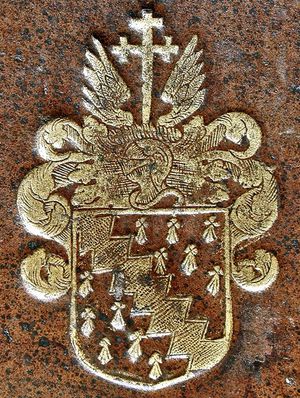Difference between revisions of "Robert Pye 1585-1662"
| (10 intermediate revisions by 4 users not shown) | |||
| Line 1: | Line 1: | ||
| − | ===[[personal | + | __NOTITLE__ |
| − | + | ===[[personal title::Sir]] [[name::Robert]] [[name::PYE]] [[date of birth::1585]]-[[date of death::1662]]=== | |
| + | [[file:RobertPye.jpg|thumb|Armorial stamp of Sir Robert Pye (British Armorial Bindings)]] | ||
====Biographical Note==== | ====Biographical Note==== | ||
| − | Robert Pye was born at [[place of | + | Robert Pye was born at [[place of birth::Much Dewchurch, Herefordshire]], son of [[family::Roger Pye]] of [[location::the Mynde]]. He did not attend a university but was admitted at the [[organisations::Middle Temple]] in 1607. Entering the service of [[associates::George Villiers]], later Duke of Buckingham, ca.1615, he became [[occupation::auditor]] of the exchequer of receipt in 1619, and was knighted in 1621. He acquired an estate at [[location::Faringdon, Berkshire]] and was [[occupation::MP]] for [[location::Bath]] in 1621 and 1624, for [[location::Ledgershall]] in 1625 and for [[location::Westminster]] in 1626. During the following decades he combined political and administrative activity with some difficulty as Civil War hostilities developed; he was on the parliamentary side and was a member of the Long Parliament 1640-48, but lost his post as [[occupation::auditor]] during the Interregnum, being restored there in 1660. |
| − | Of his two sons, [[family:: | + | Of his two sons, [[family::Sir Robert]] (ca.1622-1701) was a cavalry officer for the parliamentarian side during the Civil War, MP for Berkshire 1654-60, and held various minor administrative offices at county and court level after succeeding to the [[location::Faringdon]] estate in 1662. His younger brother [[family::Sir John Pye|Sir John]] (1626-1697) inherited other estates in Staffordshire and Derbyshire and was created a baronet in 1665. |
====Books==== | ====Books==== | ||
| Line 10: | Line 11: | ||
====Characteristic Markings==== | ====Characteristic Markings==== | ||
| − | The main evidence is the armorial stamps. C.67.b.24 in the [[present | + | The main evidence is the armorial stamps. C.67.b.24 in the [[present repository::British Library]], with the stamp attributed to [[family::Sir John]], has extensive underlining and marginal marking throughout in red crayon. |
====Sources==== | ====Sources==== | ||
<div id="sourcelist"> | <div id="sourcelist"> | ||
| + | *[https://discovery.nationalarchives.gov.uk/details/r/D1683260 Will of Sir Robert Pye, The National Archives PROB 11/308/238]. | ||
*[https://armorial.library.utoronto.ca/stamp-owners/PYE002 British Armorial Bindings]. | *[https://armorial.library.utoronto.ca/stamp-owners/PYE002 British Armorial Bindings]. | ||
*[http://www.historyofparliamentonline.org/volume/1660-1690/member/pye-sir-robert-1622-1701 History of Parliament]. | *[http://www.historyofparliamentonline.org/volume/1660-1690/member/pye-sir-robert-1622-1701 History of Parliament]. | ||
| Line 19: | Line 21: | ||
</div> | </div> | ||
| − | {{DEFAULTSORT:Pye, Robert, | + | {{DEFAULTSORT:Pye, Robert, 1585-1662}} |
[[Category:Gentry]] | [[Category:Gentry]] | ||
[[Category:Marginalia and Annotations]] | [[Category:Marginalia and Annotations]] | ||
[[Category:Armorial Stamps]] | [[Category:Armorial Stamps]] | ||
| − | |||
[[Category:Members of Parliament]] | [[Category:Members of Parliament]] | ||
| + | [[Category:All Owners]] | ||
Latest revision as of 07:33, 24 June 2022
Sir Robert PYE 1585-1662
Biographical Note
Robert Pye was born at Much Dewchurch, Herefordshire, son of Roger Pye of the Mynde. He did not attend a university but was admitted at the Middle Temple in 1607. Entering the service of George Villiers, later Duke of Buckingham, ca.1615, he became auditor of the exchequer of receipt in 1619, and was knighted in 1621. He acquired an estate at Faringdon, Berkshire and was MP for Bath in 1621 and 1624, for Ledgershall in 1625 and for Westminster in 1626. During the following decades he combined political and administrative activity with some difficulty as Civil War hostilities developed; he was on the parliamentary side and was a member of the Long Parliament 1640-48, but lost his post as auditor during the Interregnum, being restored there in 1660.
Of his two sons, Sir Robert (ca.1622-1701) was a cavalry officer for the parliamentarian side during the Civil War, MP for Berkshire 1654-60, and held various minor administrative offices at county and court level after succeeding to the Faringdon estate in 1662. His younger brother Sir John (1626-1697) inherited other estates in Staffordshire and Derbyshire and was created a baronet in 1665.
Books
Two books are recorded in the armorials database with armorial stamps (same design, different sizes) attributed to the elder Sir Robert, and two with a different (quartered) design, attributed to Sir John. The wills of neither men include any references to books; residues of goods and chattels were left simply to their main heirs (sons or wives). It is not known how large their libraries were.
Characteristic Markings
The main evidence is the armorial stamps. C.67.b.24 in the British Library, with the stamp attributed to Sir John, has extensive underlining and marginal marking throughout in red crayon.
Sources
- Will of Sir Robert Pye, The National Archives PROB 11/308/238.
- British Armorial Bindings.
- History of Parliament.
- Aylmer, G. E. "Pye, Sir Robert (bap. 1585, d. 1662), exchequer official and politician." Oxford Dictionary of National Biography.
